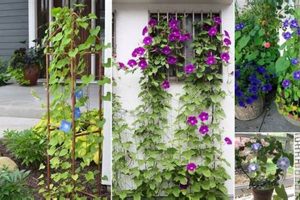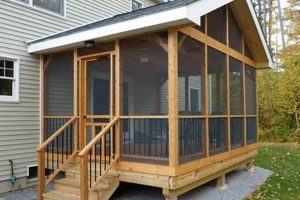The concept encompasses the creation of recreational structures for children’s play using self-sourced materials and construction methods. These projects range from simple tire swings and sandboxes to more complex climbing frames and playhouses built within residential or community spaces. The primary characteristic is the active involvement of individuals in the design and assembly process, departing from commercially manufactured options. As an illustration, a family might construct a swing set using reclaimed wood and readily available hardware, or create a climbing wall using plywood and climbing holds.
Engaging in this activity offers multiple advantages. Economically, it can provide substantial cost savings compared to purchasing pre-fabricated equipment. Furthermore, it allows for customization tailored to specific spatial constraints and children’s developmental needs. Historically, constructing play areas from available resources has been a common practice in many communities, fostering creativity, resourcefulness, and a sense of ownership among participants. This approach to play space development can also promote environmental consciousness through the utilization of recycled or repurposed materials.
The subsequent discussion will detail several design approaches for creating stimulating and safe play environments, addressing critical considerations such as material selection, structural integrity, and adherence to safety guidelines. The intention is to provide practical guidance for individuals interested in undertaking such projects, ensuring the resulting play areas are both enjoyable and secure for children.
Guidance for Constructing Play Environments
The creation of recreational areas demands careful planning and execution to ensure both structural soundness and user safety. The following provides essential considerations for those engaging in such projects.
Tip 1: Prioritize Safety Standards: Adherence to established safety guidelines is paramount. Thoroughly research and implement recommendations from organizations such as the Consumer Product Safety Commission (CPSC) regarding playground safety surfacing, equipment spacing, and fall height limitations.
Tip 2: Select Durable and Non-Toxic Materials: Opt for materials that can withstand prolonged exposure to the elements and repeated use. Treated lumber, galvanized steel, and recycled plastics are common choices. Ensure any paints, stains, or sealants are certified non-toxic and lead-free.
Tip 3: Conduct Regular Inspections: Implement a routine inspection schedule to identify and address potential hazards proactively. Check for loose fasteners, splinters, cracks, or other signs of wear and tear. Promptly repair or replace any compromised components.
Tip 4: Design for Age Appropriateness: Tailor the play structures to the developmental capabilities of the intended users. Consider factors such as reach distance, climbing ability, and cognitive understanding. Separate play areas for different age groups may be necessary.
Tip 5: Ensure Proper Ground Surfacing: Install an appropriate safety surface beneath and around all play equipment. Acceptable options include engineered wood fiber, shredded rubber, or poured-in-place rubber. Ensure the surfacing extends adequately beyond the perimeter of the equipment, as specified by safety standards.
Tip 6: Provide Adequate Supervision: Active adult supervision is crucial, particularly for younger children. Educate supervisors about potential hazards and appropriate intervention strategies.
Tip 7: Secure Structures Properly: Anchoring structures to the ground provides stability and minimizes the risk of tipping or collapse. Employ appropriate anchoring methods based on the type of equipment and the ground conditions.
Effective implementation of these recommendations will significantly enhance the safety and longevity of play areas.
The subsequent sections will delve into specific design examples and further considerations for creating stimulating and secure play environments.
1. Safety
The integration of safety principles within the realm of self-constructed recreational areas is paramount. The inherent risks associated with elevated structures, moving components, and potential impact necessitate a rigorous approach to hazard mitigation and risk assessment.
- Compliance with Established Standards
Adherence to recognized safety standards, such as those published by the Consumer Product Safety Commission (CPSC), provides a baseline for ensuring the structural integrity and safety of equipment. These standards encompass requirements for fall height limitations, impact-attenuating surfacing, and equipment spacing. Failure to comply with these guidelines can result in increased risk of injury.
- Material Selection and Treatment
The selection of appropriate materials is critical to mitigating hazards. Materials must be durable, weather-resistant, and free from toxins. Pressure-treated lumber, while offering resistance to decay, must be handled with care to avoid exposure to chemical preservatives. Similarly, paints and coatings should be non-toxic and lead-free. Inappropriate material choices can lead to structural failures or exposure to harmful substances.
- Structural Integrity and Load-Bearing Capacity
Ensuring the structural integrity of equipment requires careful consideration of load-bearing capacity and connection strength. Joints and fasteners must be adequately sized and installed to withstand anticipated forces. Regularly inspect for signs of wear, corrosion, or weakening of structural components. Improper construction techniques can compromise the stability of equipment, leading to collapse or failure under load.
- Fall Zone Design and Impact Attenuation
The design of fall zones and the implementation of impact-attenuating surfacing are essential for minimizing injury severity in the event of a fall. Appropriate surfacing materials, such as engineered wood fiber or shredded rubber, must be installed to a sufficient depth to cushion impact. The fall zone should extend adequately beyond the perimeter of the equipment, as specified by safety standards. Inadequate fall zone design can increase the risk of serious injury from falls.
The aforementioned considerations highlight the critical importance of prioritizing safety within recreational design and construction. Neglecting these factors can significantly elevate the risk of injury, underscoring the need for meticulous planning, execution, and ongoing maintenance of such areas.
2. Durability
Durability assumes critical importance in the context of self-constructed recreational equipment due to the inherent variability in material sourcing, construction techniques, and environmental condi
tions. The longevity and safety of such structures are directly proportional to the robustness of materials and the soundness of construction methods employed.
- Material Selection and Weather Resistance
The selection of materials capable of withstanding prolonged exposure to environmental elements is paramount. Untreated wood, for example, is susceptible to rot, insect infestation, and structural degradation, rendering it unsuitable for outdoor recreational structures. Conversely, pressure-treated lumber or naturally rot-resistant species like cedar offer enhanced longevity. Metal components, if used, must be corrosion-resistant to prevent weakening and potential failure. Proper material selection dictates the lifespan and safety of the structure.
- Construction Techniques and Joint Integrity
Employing robust construction techniques is crucial for ensuring structural integrity. Securely fastened joints, reinforced connections, and appropriate weight distribution are essential. Screws and bolts, rather than nails alone, provide a more robust connection. Regular inspection and maintenance of joints are necessary to identify and address any signs of weakening or degradation over time. Faulty construction methods lead to premature failure and potential hazards.
- Load-Bearing Capacity and Structural Design
The design must account for anticipated load-bearing requirements. Over-engineering, incorporating safety margins in load calculations, and utilizing appropriate support structures are essential considerations. Structures intended for multiple users or dynamic activities must be designed to withstand significant forces. Inadequate load-bearing capacity results in structural instability and risk of collapse.
- Maintenance and Preventative Measures
Regular maintenance and preventative measures extend the lifespan of self-constructed recreational equipment. Periodic inspections, tightening of fasteners, reapplication of protective coatings, and replacement of worn components are necessary. Neglecting maintenance accelerates degradation and increases the likelihood of structural failure. A proactive maintenance schedule ensures continued safety and longevity.
The preceding considerations underscore the direct correlation between durability and the long-term viability of self-constructed recreational equipment. Prioritizing robust materials, sound construction practices, and consistent maintenance ensures that these structures provide safe and enjoyable play experiences for an extended period. Neglecting these aspects can result in premature deterioration and potential safety hazards.
3. Cost-Effectiveness
The economic advantages inherent in constructing recreational equipment independently represent a primary driver for many individuals and communities. This approach offers a potentially significant reduction in capital expenditure compared to purchasing commercially manufactured systems, contingent upon resourcefulness in material acquisition and the efficient utilization of labor.
- Material Sourcing and Repurposing
One of the most significant cost-saving opportunities lies in the acquisition of materials. Utilizing reclaimed lumber, recycled tires, and repurposed metal components can substantially reduce material expenses. Construction projects can also benefit from partnerships with local businesses or community organizations that may have surplus materials available. Careful sourcing and creative repurposing directly translate to lower overall project costs.
- Labor Contribution and Skill Diversification
Engaging in self-construction necessitates the investment of personal or community labor. While this translates to time commitment, it obviates the need for professional installation services, further reducing costs. Moreover, the process fosters skill development in areas such as carpentry, welding, and design, potentially contributing to future cost-saving opportunities. Labor investment, therefore, represents a trade-off between time and monetary expense.
- Customization and Scalability
The ability to customize designs allows for the construction of equipment tailored to specific spatial constraints and budgetary limitations. Projects can be initiated on a smaller scale and expanded incrementally as resources become available, offering a more manageable financial commitment. This scalability provides flexibility that pre-fabricated options may lack, enhancing cost-effectiveness over time.
- Long-Term Maintenance and Repair
While the initial investment may be lower, long-term maintenance costs must be considered. Selecting durable materials and employing sound construction techniques minimizes the need for frequent repairs or replacements. Moreover, self-construction facilitates easier access to replacement parts and simplifies the repair process, further contributing to long-term cost savings. Investing in quality materials and construction practices mitigates potential future expenses.
The strategic application of these principles enables the development of recreational areas that are not only engaging and safe but also economically sustainable. By carefully managing material acquisition, labor investment, design flexibility, and long-term maintenance, the cost-effectiveness of self-constructed recreational equipment can be demonstrably enhanced, providing a viable alternative to commercially manufactured options.
4. Creativity
In the realm of self-constructed recreational environments, ingenuity serves as a vital catalyst, shaping not only the aesthetic qualities but also the functional attributes and developmental opportunities afforded to children. It transcends mere decoration, fundamentally influencing the design, construction, and utilization of play spaces.
- Imaginative Design and Spatial Configuration
Originality in design allows for the creation of play structures that transcend conventional forms. For instance, a climbing frame might be envisioned as a stylized tree, incorporating natural elements and varying levels of difficulty. Spatial configuration can be optimized to promote exploration, discovery, and imaginative play scenarios. The implementation of novel design concepts transforms ordinary spaces into stimulating environments.
- Resourceful Material Utilization and Adaptation
Self-constructed projects often necessitate the creative adaptation of readily available materials. Discarded tires, wooden pallets, and plastic containers can be repurposed into swings, climbing walls, and tunnels. The resourceful utilization of such materials encourages problem-solving and resourcefulness, fostering an appreciation for sustainability and environmental stewardship. Effective material adaptation minimizes waste and maximizes the potential of available resources.
- Integration of Thematic Elements and Narrative Frameworks
Creativity enables the infusion of thematic elements and narrative frameworks into the design of play areas. A pirate ship-themed structure, for example, might incorporate ropes, ladders, and lookout points, encouraging children to engage in imaginative role-playing. The integration of thematic elements enhances engagement and provides a context for soc
ial interaction and collaborative play. Narrative frameworks transform play spaces into immersive environments. - Promotion of Problem-Solving and Cognitive Development
The process of self-construction inherently fosters problem-solving skills and cognitive development. Designing and building play structures requires individuals to consider structural integrity, safety, and functionality. The implementation of unconventional solutions and innovative approaches encourages critical thinking and creative problem-solving. Self-construction becomes a vehicle for fostering cognitive development and enhancing problem-solving capabilities.
The synthesis of these facets demonstrates how ingenuity serves as a cornerstone in creating bespoke recreational equipment. These areas not only fulfill fundamental needs for physical activity but also cultivate imagination, resourcefulness, and problem-solving abilities. By embracing creativity, the potential of DIY recreational environments to enrich children’s lives is significantly amplified.
5. Sustainability
The integration of sustainability principles into the design and construction of self-made play equipment represents a conscientious approach to resource management and environmental stewardship. It necessitates a deliberate consideration of material lifecycles, ecological impact, and the long-term consequences of design choices.
- Material Selection and Life Cycle Assessment
Choosing materials with minimal environmental impact is critical. This includes prioritizing recycled or reclaimed resources, such as repurposed wood, recycled plastic, or used tires. A comprehensive life cycle assessment considers the energy consumption, pollution, and waste generation associated with each material from extraction to disposal, enabling informed decisions that minimize environmental burden. For instance, utilizing reclaimed lumber from deconstructed buildings not only reduces the demand for new timber but also prevents the lumber from ending up in landfills.
- Non-Toxic Treatments and Finishes
Traditional wood preservatives and paints often contain harmful chemicals that can leach into the environment or pose risks to children’s health. Opting for non-toxic alternatives, such as water-based stains, linseed oil, or beeswax finishes, minimizes the potential for environmental contamination and ensures the safety of users. This aligns with principles of green chemistry, which prioritize the development of inherently safer products and processes.
- Durability and Longevity
Designing for durability reduces the need for frequent replacements, minimizing waste and resource consumption over time. Employing robust construction techniques, selecting weather-resistant materials, and implementing regular maintenance practices extend the lifespan of equipment. For example, using naturally rot-resistant wood species, such as cedar or redwood, and applying protective coatings can significantly increase the longevity of wooden play structures, thus reducing the environmental impact associated with manufacturing and disposal.
- Deconstruction and End-of-Life Management
Planning for the eventual deconstruction and disposal of equipment is essential. Designing structures that can be easily disassembled and components that can be repurposed or recycled minimizes waste. Avoiding the use of permanent adhesives and fasteners facilitates disassembly. Proper end-of-life management ensures that materials are diverted from landfills and reintegrated into the materials cycle. This cyclical approach reduces resource depletion and promotes a circular economy.
The conscientious application of sustainable practices to the creation of recreational spaces not only minimizes environmental impact but also provides educational opportunities for children, fostering an awareness of environmental responsibility and promoting a culture of sustainability from an early age. The fusion of creative design with ecological awareness can yield engaging and enriching play environments that benefit both the users and the planet.
6. Age-Appropriateness
Age-appropriateness stands as a cornerstone principle in the design and implementation of self-constructed recreational equipment. A failure to adequately consider the developmental capabilities and physical limitations of the intended users can result in increased risk of injury and diminished play value. Therefore, meticulous planning and execution are crucial to ensure that the resulting play environment effectively caters to the specific needs of the target age group.
- Scale and Dimensions
The physical dimensions of play structures must align with the anthropometric data of the intended age group. Climbing heights, reach distances, and passageway widths should be scaled appropriately to accommodate the physical capabilities of children within that age range. For example, a climbing wall designed for toddlers should feature lower heights and closer handholds compared to one intended for older children. Discrepancies between equipment dimensions and user capabilities can lead to falls, strains, or other injuries.
- Complexity and Cognitive Challenge
The complexity of play activities should be commensurate with the cognitive abilities of the intended age group. Structures designed for younger children should prioritize simple, intuitive play patterns, while those intended for older children can incorporate more challenging problem-solving elements. Overly complex designs can lead to frustration and disengagement, while overly simplistic designs may fail to provide adequate stimulation. The ideal balance promotes cognitive growth without exceeding the child’s developmental capacity.
- Safety Features and Risk Mitigation
Safety features must be tailored to the specific risks associated with the target age group. Younger children require increased supervision and more restrictive safety measures, such as enclosed platforms and impact-attenuating surfacing. Older children may benefit from equipment that encourages calculated risk-taking under controlled conditions, fostering resilience and self-assessment. Safety protocols should be implemented in accordance with the developmental maturity of the users.
- Accessibility and Inclusivity
Play environments should be designed to accommodate children with diverse abilities and needs. Ramps, transfer platforms, and adaptive equipment can facilitate participation for children with mobility impairments. Sensory elements, such as textured surfaces and auditory features, can enhance the play experience for children with sensory processing differences. Inclusivity ensures that all children have equal opportunities to engage in play and social interaction.
The integration of age-appropriate considerations into DIY recreational construction projects fundamentally shapes the utility and safety of the resulting play spaces. By meticulously aligning design elements with the developmental capabilities and physical limitations of the intended users, individuals can create environments that foster growth, promote inclusivity, and minimize the risk of injury. This thoughtful approach elevates the value of self-constructed recreational equipment, transforming them into invalua
ble resources for children’s development.
Frequently Asked Questions
The following addresses common inquiries and misconceptions regarding the design, construction, and maintenance of recreational structures. These answers are intended to provide clarity and promote informed decision-making.
Question 1: What constitutes a safe surface for fall zones under recreational equipment?
Acceptable surfaces include engineered wood fiber, shredded rubber mulch, poured-in-place rubber, or sand/pea gravel at sufficient depth. The selected material must meet established standards for impact attenuation to minimize the risk of injury from falls. Proper installation and maintenance are essential for maintaining effectiveness.
Question 2: How frequently should self-constructed recreational equipment be inspected for safety?
Equipment should undergo routine inspections at least monthly, with more frequent inspections recommended for high-usage areas or following inclement weather. Inspections should focus on identifying loose fasteners, splinters, cracks, corrosion, and other signs of wear or damage. Prompt repairs are crucial for maintaining safety standards.
Question 3: Is pressure-treated lumber safe for use in recreational equipment intended for children?
While pressure-treated lumber offers resistance to decay and insect infestation, precautions must be taken to minimize exposure to chemical preservatives. Select lumber treated with approved preservatives and allow it to weather for several weeks before use. Seal the lumber with a non-toxic sealant to further reduce potential exposure.
Question 4: What are the key considerations for designing age-appropriate recreational equipment?
Design considerations include the scale and dimensions of the equipment, the complexity of play activities, and the implementation of appropriate safety features. Climbing heights, reach distances, and passageway widths should align with the physical capabilities of the intended age group. Activities should challenge cognitive abilities without exceeding developmental capacity.
Question 5: How can sustainability be incorporated into the construction of recreational equipment?
Sustainability can be enhanced through the use of recycled or reclaimed materials, the selection of non-toxic treatments and finishes, the design for durability and longevity, and the planning for deconstruction and end-of-life management. These practices minimize environmental impact and promote resource conservation.
Question 6: What resources are available for learning about recreational equipment safety standards and guidelines?
The Consumer Product Safety Commission (CPSC) provides comprehensive guidelines for playground safety. Industry organizations, such as the International Play Equipment Manufacturers Association (IPEMA), also offer valuable resources and certification programs. Consulting with qualified professionals is recommended for complex projects.
These FAQs address critical considerations related to the safety, design, sustainability, and maintenance of recreational structures. Adhering to established standards and employing sound construction practices are essential for creating safe and enjoyable play environments.
The subsequent sections will explore specific design examples and further considerations for creating stimulating and secure play environments.
Concluding Remarks
This examination of self-directed recreational equipment creation, encompassing “diy playground equipment ideas,” has underscored the significance of safety, durability, cost-effectiveness, ingenuity, ecological sensitivity, and age-appropriate design. The successful implementation of these tenets is paramount to constructing play spaces that are both stimulating and secure. The decision to undertake such projects requires a thorough understanding of relevant safety standards, material properties, and construction techniques.
Engaging in this endeavor presents opportunities for resourcefulness, skill development, and community collaboration. However, it also carries inherent responsibilities. Prioritizing safety and sustainability ensures that these spaces provide enduring benefits to children and the environment. Thoughtful planning, diligent execution, and ongoing maintenance are essential for realizing the full potential of creating play areas through self-directed efforts.







